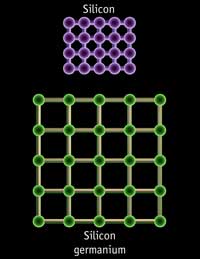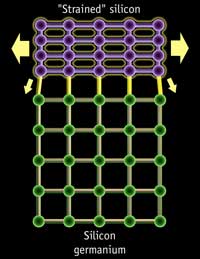Intel's Pentium 4 E: Prescott Arrives with Luggage
by Anand Lal Shimpi & Derek Wilson on February 1, 2004 3:06 PM EST- Posted in
- CPUs
Something to be proud about
Intel is particularly proud of their 90nm process as it incorporates new technologies that are a first in desktop microprocessors. The biggest of them all is the use of Strained Silicon, which we explained back in August of 2002 when Intel first announced that they would use the technology:
Strained Silicon works by effectively stretching the silicon in the channel region of the transistor. The engineers at Intel's fab facilities don't sit there and pull on both ends of the silicon in order to get it to stretch; rather they place the silicon on top of a substrate whose atoms are already spaced further apart than the silicon that needs to be stretched. The result of this is that the silicon atoms on top of the substrate will stretch to match the spacing of the substrate below, thus "stretching" the silicon in the channel.
 |
 |
|
Silicon is "strained" by using a substrate of more widely spaced atoms below the silicon channel of a transistor. (Images courtesy of IBM) |
|
With more well spaced silicon atoms, electrons can now flow with less resistance in the channel meaning that more current can flow through the channel when needed. The end result is a 10 - 20% increase in drive current, or the current flowing through the channel of the transistor.
![]()
Intel claims that their Strained Silicon technology has no real downsides (unlike competing solutions) other than its 2% increase in manufacturing costs. Intel's 90nm process will make use of Strained Silicon technology to improve the performance of their 90nm transistors.
Intel’s 90nm process does not make use of Silicon on Insulator and according to their manufacturing roadmaps it never will. Intel will introduce SOI on their 65nm process in 2005.

Prescott's 112 mm^2 die
Prescott is Intel’s first desktop microprocessor to have 7 metal layers, 2 fewer layers than AMD’s Athlon 64. Intel had to add the 7th layer simply because of the skyrocketing transistor count of Prescott (125 million vs. Northwood’s 55 million). It’s not normally desirable to increase the number of metal layers you have on a chip as it increases manufacturing complexity and cost, but in some cases it is unavoidable. The fact that Intel was able to keep the number of metal layers down to 7 is quite impressive, as AMD had to resort to 9 layers dating back to the introduction of their Thoroughbred-B Athlon XP core to keep clock speeds high.
|
CPU Core Comparison |
|||||
| Code Name |
Willamette |
Northwood |
Northwood EE |
Prescott |
AMD Athlon 64 |
| Manufacturing Process |
0.18-micron |
0.13-micron |
0.13-micron |
90 nm |
0.13-micron |
| Die Size |
217 mm^2 |
131 mm^2 |
237 mm^2 |
112 mm^2 |
193 mm^2 |
| Metal Layers |
6 |
6 |
6 |
7 |
9 |
| Transistor Count |
42 Million |
55 Million |
178 Million |
125 Million |
105.9 Million |
| Voltage |
1.750V |
1.50V |
1.50V |
1.385V |
1.50V |
| Clock Speeds |
1.3 - 2.0GHz |
1.6 - 3.4GHz |
3.2 - 3.4GHz |
2.8 - 4GHz+ |
2.0GHz+ |
| L1 Instruction/Trace Cache | 12K µops |
12K µops |
12K µops |
12K µops |
64KB |
| L1 Data Cache | 8KB |
8KB |
8KB |
16KB |
64KB |
| L2 Cache | 256KB |
512KB |
512KB |
1MB |
1MB |
| L3 Cache | N/A |
N/A |
2MB |
N/A |
N/A |










104 Comments
View All Comments
terrywongintra - Monday, February 2, 2004 - link
anybody benchmark prescott over northwood in entry-server environment? i'm installing 3 servers later by using intel 875p (s875wp1-e) entry server board n p4 2.8, need to decide prescott or northwood to use.sipc660 - Monday, February 2, 2004 - link
i don't understand why some people are bashing such a good inovation that was long overdue from intel.a pc that doubles as a heater and at only 100-200W power consumption.
Let me remind you that a conventional fan heater eats up a kilowatt/hour of power.
Think positive
* space reduction
* enormous power savings (pc + fan heater)
* extremly sophisticated looking fan haeter
* extremly safe casing. reduces burn injuries
to pets and children.
* finely tunable temperature settings (only need
to overclock by small increments)
* coupled with an lcd it features the best
looking temperature adjustment one has ever
witnessed on a heater
* child proof as it features thermal shutdown
* anyone having a laugh thus far
* will soon feature on american idol
the worst singers will receive one p4 E based
unit each. That should make people
think twice about auditioning thus making
sure only true talent shows up.
* gives dell new marketing potential and a crack
at a long desired consumer heating electronic
* amd is nowhere near this advancement in thermal
thechnology leaving intel way ahead
hope you enjoyed some of my thoughts
Other than that good article and some good comments.
on another note i don't understand why people run and fill intels pockets so intel can hide their engineering mistakes with unseen propaganda, while there is an obvious choice.
choice is Advanced Micro Devices all until intel gets their act together.
go amd...
Stlr22 - Monday, February 2, 2004 - link
INTC - "Intel roadmap says Prescott will hit 4.2 GHz by Q1 '05. My guess is that it is already running at 4 GHz but just needs to be fine tuned to reduce the heat."Maybe they are trying to keep it under the 200watt mark? ;-)
INTC - Monday, February 2, 2004 - link
I think CRAMITPAL must have sat on a hot Prescott and got it stuck where the sun doesn't shine - that would explain all of the yelling and screaming and friggin this and friggin that going on. "Approved mobo, approved PC case cooling system, approved heatsink & fan - and you better not use Artic Silver or else it will void your warranty..." gee - didn't we just hear that when Athlon XPs came out? It brings to mind when TechTV put their dual Athlon MP rig together and it started smoking and catching on fire when they fired it up the first time on live television during their show.Intel roadmap says Prescott will hit 4.2 GHz by Q1 '05. My guess is that it is already running at 4 GHz but just needs to be fine tuned to reduce the heat. I bet the experts (or self proclaimed experts such as CRAM) were betting that Northwood could not hit 3 GHz and look where it is at today. Video card GPUs today are hitting 70 degrees C plus at full load but they do fine with cooling in the same PC cases.
CRAMITPAL - Monday, February 2, 2004 - link
Dealing with the FLAME THROWER's heat issues is only one aspect of Prescott's problems. The chip is a DOG and it requires an "approved Mobo" and an "approved PC case cooling system", a premo PSU cause the friggin thing draws 100+ Watts and this crap all costs money you don't need to spend on an A64 system that is faster, runs cooler, and does both 32/64 bit processing faster. How difficult is THIS to comprehend???Ain't no way Intel is gonna be able to Spin this one despite the obvious "press material" they supplied to all the reviewers to PIMP that Prescott was designed to reach 5 Gigs. Pigs will fly lightyears before Prescott runs at 5 Gigs.
Time to GET REAL folks. Prescott sucks and every hardware review site politely stated so in "political speak".
Stlr22 - Monday, February 2, 2004 - link
((((((((((((CRAMITPAL)))))))))))))))It's ok man. It's ok. Everything will be alright.
;-)
scosta - Monday, February 2, 2004 - link
#38 - About your "Did anyone catch the error in Pipelining: 101?".There is no error. The time it takes to travel the pipelane is just a kind of process delay. What matters is the rate at witch finished/processed results come out of the pipeline. In the case of the 0.5ns/10 stage pipelane you will get one finished result every 0.5ns, twice as many as in the case of the 1ns/5 stage pipeline.
If the pipelines were building motorcycles, you woud get, respectively, 1 and 2 motorcycles every ns. And that is the point.
LordSnailz - Monday, February 2, 2004 - link
I'm sure the prescotts will get hotter as the speed increases but you can't forget there are companies out there that specializes in this area. There are 3 companies that I know of that are doing research on ways to reduce the heat, for instance, they're planning on placing a piece of silicon with etch lines on top of the CPU and run some type of coolant through it. Much like the radiator concept.My point is, Intel doesn't have to worry about the heat too much since there are companies out there fighting that battle. Intel will just concentrate on achieving those higher speeds and the temp control solution will come.
scosta - Monday, February 2, 2004 - link
You can find thermal power information in the also excelent "Aces Hardware" Prescot review here:[L=myurl]http://www.aceshardware.com/read.jsp?id=60000317[/l]
In resume, we have the following Typical Thermal Power :
P4 3.2 GHz (Northwood) - 82W
P4E 3.2 GHz (Prescot) - 103W
Note that, at the same clock speed and with the same or lesser performance, the Prescot dissipates 25% more power than Northwood. This means that with a similar cooling system, the Prescot has to run substancially hoter.
As AcesHardware says,
[Q]After running a 3DSMax rendering and restarting the PC, the BIOS reported that the 3.2 GHz Northwood was at about 45-47°C, while Prescott was flirting with 64-66°C. Mind you, this is measured on a motherboard completely exposed to the cool air (18°C) of our lab.[/Q]
So, what will the ~5GHx Prescot dissipate? 200W ?
Will we all be forced to run PCs with bulky, expensive, etc, criogenic cooling systems?. I for one wont. This power consumption escalation has to stop. Intel and AMD have to improve the performace of their CPUs by improving the CPU archytecture and manufacturing processes, not by trowing more and more electrical power at the problem.
And those are my 2 cents.
CRAMITPAL - Monday, February 2, 2004 - link
Prescott will never go above 3.8 Gig. even with the 3rd revision of the 90 nano process. Tejas will make it to just over 4.0 Gig. with a little luck but it won't be anything to write home about either based on current knowledge.Intel has fallen and can't get it up!